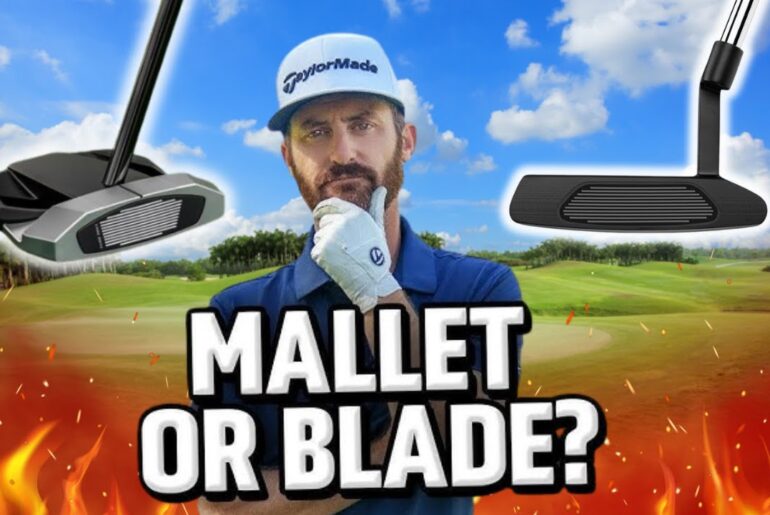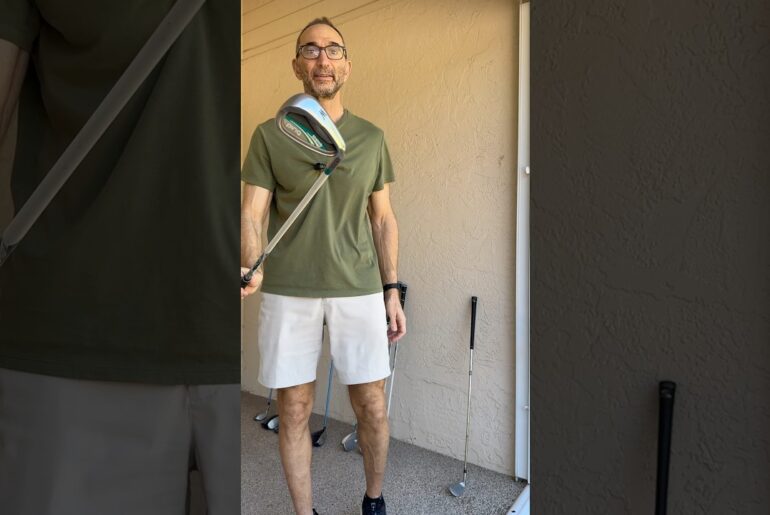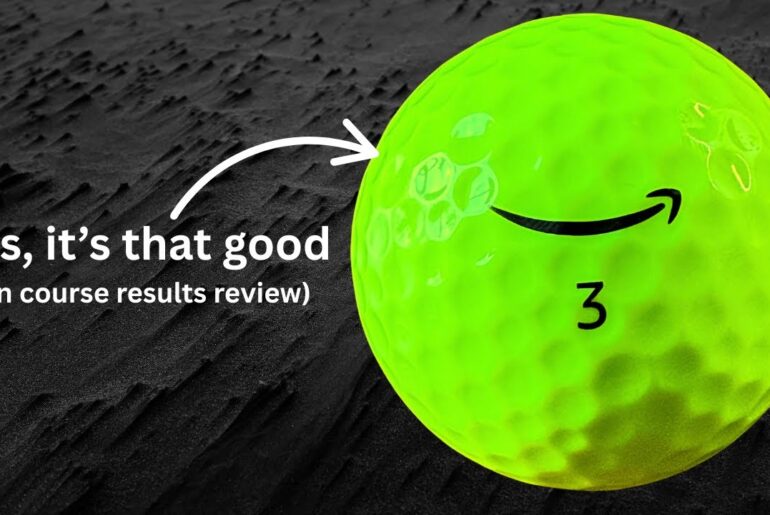🟡 Amazon’s New Golf Ball Tested – Is It Actually Any Good? | Full Performance Review + Ball Cut Open! 🟡
Amazon has officially entered the golf ball market with its own brand of balls — but how do they actually perform? Should Titleist, Callaway, and TaylorMade be worried? In this video, I put the new Amazon Basics golf ball through a full, data-driven test to find out exactly what it’s capable of.
We’ll cover:
🏌️♂️ 50-yard wedge spin & feel test
🏌️♂️ 8-iron launch, distance & spin comparison
🏌️♂️ Driver ball speed & carry at both my speed and average golfer speed
⚙️ Full analysis against the Callaway Supersoft (its main competition)
🔪 And yes — I cut the ball open to see what’s really inside!
You’ll see all the performance numbers, my honest thoughts, and whether this £17/$24 golf ball is a total bargain or a budget blunder.
If you’re thinking about trying the Amazon golf ball yourself, make sure you watch this before you buy!
💬 Comment below — what’s your current gamer ball and why do you play it?
👍 Like the video if you found it helpful
🔔 Subscribe so you don’t miss the next ball test
📺 Watch Next: My full Callaway SuperSoft test here → https://youtu.be/cNoMJgoFk5E
#AmazonBasics #GolfBallReview #GolfBallTest #GolfGear #AmazonGolf #CallawaySupersoft #GolfComparison #GolfReview #GolfTesting
Hi and welcome. It’s been the talk of the golfing world the last few days. Amazon has released its own brand golf ball. Should titleist Callaway and Tailor Made be worried. Today I’m going to be doing a comprehensive test. We’re going to be hitting the ball. We’re going to be looking at data. We’re going to analyze whether this golf ball is good or bad. We’re also going to be cutting the golf ball open just to see what’s inside and confirm what Amazon are telling us, which isn’t a lot. So, everyone, here it is. The balls arrived in a plain brown Amazon packaging. Let’s have a little look at what’s inside. So, there we have it. The balls are actually packaged in individual sleeves, which was something that people were questioning whether would be the case even. But you can see they’re pretty basic. [Applause] So, let’s take one of these sleeves out and let’s have a further look at it. You can clearly see that it’s just that Amazon basics. It has nothing on the side, nothing on the back, top or the bottom. It’s a planer packaging as I’ve ever seen on a golf ball, minus the titleless prototypes. So, this sort of packaging will obviously help Amazon to keep down the price of their product. But it does bring my first question, which is the vague information we have about this golf ball. not only on the packaging, but also on Amazon’s website. Have a look and see what it says. It’s very, very generic and doesn’t really provide any information on what this ball is or who this ball’s for. What information we have gleaned from the industry about this ball is that it’s manufactured in Vietnam by a company that makes some of the Kirkland balls for Costco and also some of the PXG models. So, what I can tell you about this ball is it’s a two-piece ball. It’s a soft core and it’s an ionma cover, which puts it in a direct kind of comparison with Callaway Superoft. So, here we go. Let’s take one of these balls out of the sleeve and see what we’ve actually got. [Applause] So the first thing that I noticed apart from obviously the minimalistic smile and the number and the marking on the side obviously they suggest for helping you line up putting and has core soft written on it is how bright white this golf ball is like It’s disturbingly bright white and for me personally, I think it cheapens it and makes it look more like a budget ball. So, in the UK, Amazon are selling this ball in white for £17 and they’re selling the luminous yellow version for £22. Now, even better than that is if you’re in America, you can buy 24 of these golf balls for $24. Now, even for my rudimentary maths, that’s $1 a ball. But if they’re that cheap, there must be a catch, right? That’s what we’re here to find out. But why has Amazon joined this already saturated marketplace? I don’t know the answer, but my guess is quite straightforward and simple. Amazon knows how many Callaway Super Soft balls it sells, and I’m telling you, it sells a lot of Callaway Super Soft golf balls. So, I reckon that it’s looked at it and worked out that it can find someone that can manufacture a ball that’s fairly similar to Callaway Super Soft Ball. they can do it at a cheaper price and they make more profit. So, I’ve done my normal ball test on this Amazon golf ball. I’ve hit some 50 yard shots with my sand wedge. I’ve hit some 8 iron full shots at my speed and some full speed drivers. And what I’ve also done is I then also hit some 8 iron shots at average golfer speed. That’s around 70 to 75 mph club head speed. And I’ve also hit some drivers at average club head speed. And that’s around 95 miles an hour. So, we can bring out a decent amount of data, not only for players with faster swing speeds, but also for your average golfer. Okay, so let’s go and watch me smashing this golf ball around for a little bit before we come back and have a look at the data. [Music] Okay, I’ve hit a bunch of shots with this golf ball and you’ve seen some of them. So, now it’s time for us to have a look at the data. Right, so let’s first look at the 50 yard shots. One of the things that was really bugging me with this ball was the actual feel. It’s so difficult to describe and not anything that I’ve really ever felt before. It almost felt squishy when you hit it. And there was so little feedback. I was really struggling to actually hit the ball 50 yards with swings that I would normally make that would hit the ball 50 yards. As well as that, I was getting some really random launch conditions. I had a couple of 50 yard pitch shots that when I hit actually hit the roof of my net before they hit the back of the net. That’s something that I just don’t see unless I’m trying to hit a full lob wedge in my net. And it was really disconcerting and really again just didn’t help with me being able to feel that I could hit a 50 yard shot consistently. So the big takeaway from the 50 yard shots apart from the feel and that lack of consistency I was feeling was the fact that the spin numbers were just so low. Again, on these balls, we normally expect them to be low and you can’t compare them to tour balls, but at 4984, that’s really virtually unplayable. I’ve popped below the Callaway Super Soft results that I did from around about a week ago, just so you’ve got a comparison because I’m pretty much convinced that these balls are sort of the like for like balls that people will be thinking about trying to save some money on Supersoft and buy Amazon Basics. But even the numbers of the Amazon ball are worse than the Super Soft. So when we look at the launch, you can see it’s 30.1. That’s really, really high. And as I say, I had some really random shots within that test. And some of the balls, especially the ones that were getting close to or hitting the roof of the net, were launching at 35°. It’s just something that I just haven’t seen from multiple other balls that I’ve hit. So let’s now move on to eight iron shots at my speed. Now again, I’ve put the Callaway Super Soft ball details just below because I think ultimately everybody realizes that this Amazon Basics ball isn’t going to have any reference point against something like a Prov1. It’s not targeted at a Prov1 player, but I feel it is targeted at someone that may be wanting to buy the Callaway Superoft. So, let’s compare apples to apples, shall we? As I have seen in other testing that I’ve done, funnily enough, when you get to this mid iron space around about seven or eight iron, the actual carry distance that the ball goes can quite often not be that different. And that’s usually very much down to the launch conditions of the ball. What we can see is what we see from a lot of soft balls. This ball is launching high and it’s spinning low. And what that does is that allows it to maintain a carry equivalent to a much more expensive turbo ball, but it’s doing it in a completely different way. The turbo will come out lower with significantly more spin. The other thing we can see here again super soft figures is that the spin numbers are even lower than that and the super soft is a notoriously low spinning golf ball. If we move now to the average golfer speed for an 8 iron, you can see it’s just not a lot different really. The ball speeds maybe not quite there, but the launch conditions and spin numbers are obviously equivalent to what we’ve been seeing. And the net result is pretty much what we see. As I say, they had this weird thing that I’m finding within this mid-range of irons where balls are carrying around about the same distance. They’re just getting there in different ways. If we now move on to looking at driver at my speed, you can see I was about a mile an hour down on club head speed, but ball speeds were pretty good. What I did find a problem was that obviously we can see the spin number there of 2024, but that was really, really inconsistent in how it was performing. I had some shots that were bumping at that number, but I also had some that were really, really low spin. I had some shots that were 1,500 RPMs and lower, and that’s just not manageable to actually play consistent golf out on the golf course. And something again that I just don’t tend to see from most golf balls. Even some of the balls that don’t spin tend to hover much more consistently around the 2,000 mark. And I like to see my driver spin to be closer to 25,500 to be able to help control the speed that I’m creating. But this ball was again just inconsistent in the numbers it was producing and the low level that some of the shots were coming out with spin was just really quite a concern for me. And again, if we have a look at driver for average speed, we see very much the same kind of thing. It’s a very comparable ball in the speed that it’s creating and the distance that it’s creating to supersoft. Again, that’s not the highest marker to set, but it is the competitor as I see it in this bull market. The trouble is with the spin numbers being only around 1,800, you know, again, that’s really really difficult to manage. And if you then get that dropping down further from that point, I mean, it’s just really, really low and just very inconsistent at the figures it’s producing. So, regarding the chipping, it was really the feel of the ball again that was causing me a problem. There was so little feedback, it was just really difficult to judge how the ball was going to react. It was also coming out high and with no spin. Again, when it came to the putting, the feel was maybe a little bit better, but I was really, really struggling with being able to get speed control with this ball. It was really difficult to get any feedback from the putter face as to how far the ball was likely to travel. Right, before we cut this ball open and have a look at what’s on the inside and come to a conclusion, it’s now time for you to subscribe to the channel and also like this video. Right, so we cut this ball open. You can see the inside. To be fair, it’s not the most interesting. It’s got a very light colored core, which means that it’s really difficult to separate what is core from what is cover. It’s definitely a two-piece ball, and certainly the cover does look a little bit on the thinner side for an ionimma ball. So again, just to cover the inside of this golf ball, if we have a look at it here, I’m going to bring it up and forward to the camera. And you can see with that light color, it’s really difficult to see what the core and the cover differential is. Now, if I bring up the Callaway Super Soft here, obviously you can see it’s a much darker color on the inside, but you can also see that that makes it significantly clearer to see the distinction between the cover and the core, but they’re not really dissimilar when you look in detail at them. So, what’s my ultimate conclusion here? Well, let’s face it. This ball isn’t marketed at me. This ball is marketed at someone who’s likely to be buying something like the Callaway Super Soft off of Amazon. And this is giving them another option to go from £25 a dozen to £17 a dozen for 12 balls. Would that make you look at it? Yeah, it probably would. The trouble I have here is the fact that the spin numbers are just low across the ball and the ball just appears to be lacking consistency. So even at a cheap budget price, it really feels to me that you’re just not getting the quality that you would need to be able to play half decent golf out on the golf course or at least for the ball to go where you would expect it from the strike you’re making. As I’ve mentioned previously, I think one of the other massive concerns here is just a lack of consistency that I found in this golf ball with the way the ball was launching and spinning and just the variations that were occurring with shots that felt like they were very, very similar in strike and performance. I was just getting different results. And again, out on the golf course, that’s just not going to help your golf. Even if you want to play a really, really soft golf ball that is lacking spin and losing you distance, the one thing you need it to do is to fly, flight, and go as far as you expect it to go each time you hit it. Look, I understand this is a cheap budget golf ball, and if £17 a dozen is all you can afford to pay for golf balls or you’re losing a dozen every single round, then it’s probably worth having a look at. At the end of the day, if you’re the person that’s playing one of these very, very soft golf balls like Callaway Super Soft or one from any of the other manufacturers, then spending 17 quid to try this against those to see how you think, it’s probably not a difficult thing to do. Ultimately, I think I would be quite keen to see what happens with Amazon and a second generation of this golf ball. I think it’s clear that this first foray into golf ball manufacturing and working with a supplier just hasn’t quite come up with a ball that’s good enough even at the lowest price. But quite often we’ve seen with companies like this including Costco and their Kirkland that their further generations of golf balls improve and take on better properties than the original ones did. Don’t forget to like this video and subscribe to the channel. It’s free to do and it really helps me out a lot. And down in the comments below, I want to know what your current game of ball is and why you play it. If you want to see my full Callaway Super Soft test, that’s up here. I’m Graeme and I’ll catch you on the course soon. [Music]








3 Comments
💬 What do you think — would you try Amazon’s new golf ball or stick with your current gamer?
I was really surprised by some of the results in this test 😅
Let me know your go-to golf ball and why you use it down below ⬇
👍 Don’t forget to drop a like if you enjoyed the video, and
🔔 Subscribe so you don’t miss the next big golf test coming soon!
Ionomer – no thanks
Obviously there aimed at beginner/high handicap golfers and ionomer does spin less than urethane but if its geared toward high handicap golfers you want less spin. (less means less sidespin).